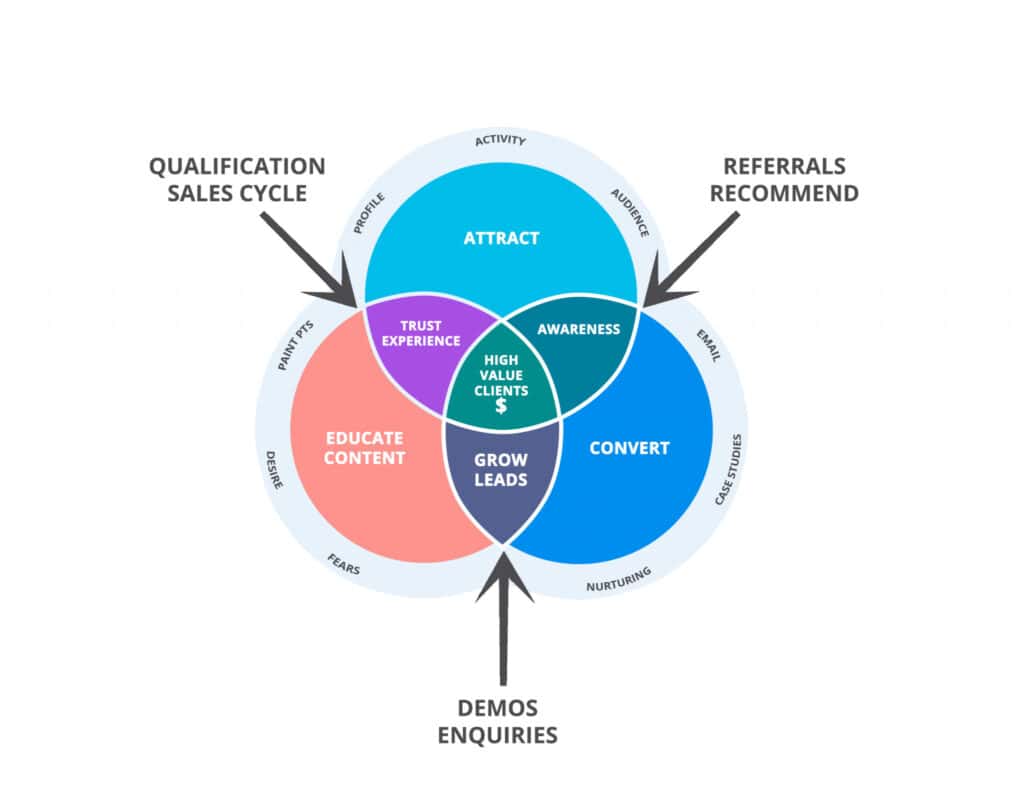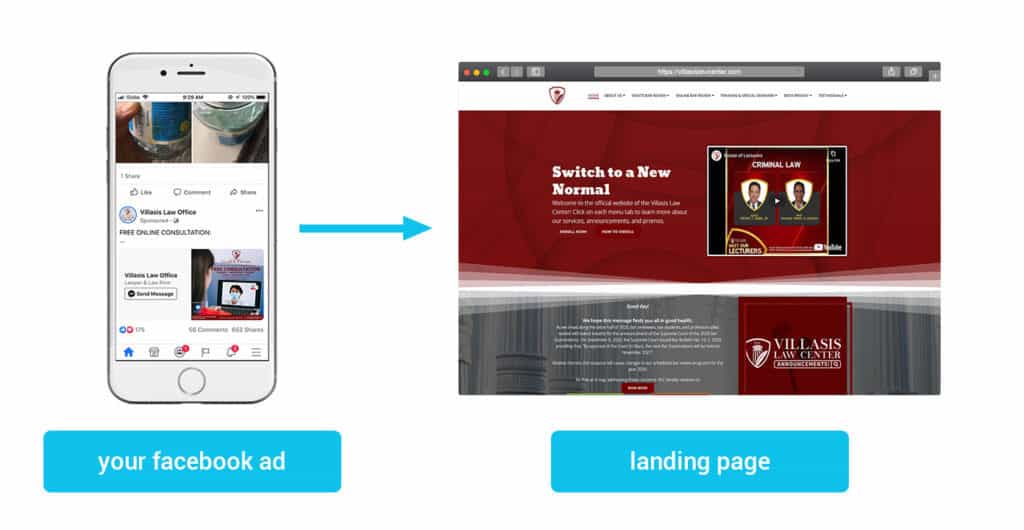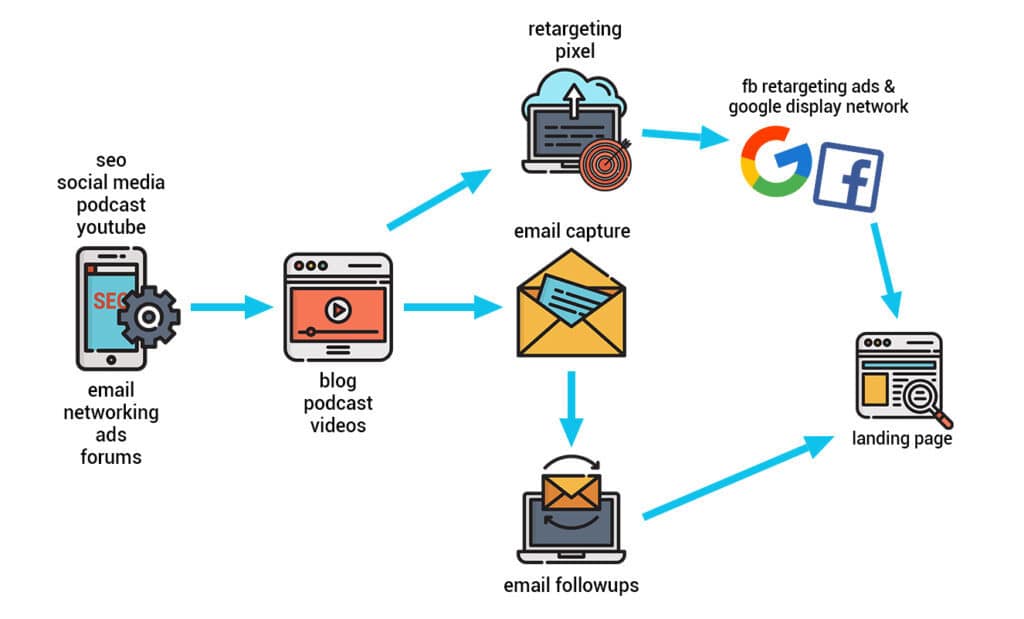The Ultimate Guide to LAW FIRM Marketing
It’s not uncommon for law firms to add marketing to the “I’ll deal with this later” pile. Billable client work will always take precedence because, well, it gets the bills paid.
But most law firms understand the significance of marketing in their firm’s growth development but don’t necessarily know how it should be used.
We find that there’s still a firm reliance on traditional marketing methods such as generating partner leads through referral networking and very little focus on building a digital marketing strategy.
Given that we live in an age where all attention revolves around the internet, it’s impossible to ignore digital marketing when creating your law firm’s overall marketing strategy.
Traditional marketing usually focuses on mainstream advertising, be it on the radio, on a billboard or even on social media, hoping that it would reach as many people as possible.
Whereas digital marketing offers an excellent approach to targeting a specific audience who will find you have to say as relevant and helpful.
Now imagine receiving a minimum of 12 – 15 bookings into your calendar for potential client leads who want to hear from you and have you as their representing firm – all without too much effort or too much networking.
So, we’ve created this guide to show you the exact content marketing strategies we deployed to help our clients achieve anywhere from 2x to 4x the amount of inbound (yes, inbound) leads in under 12 months.
So, What is Content Marketing?
Content marketing is a type of marketing that involves creating and sharing education material in the form:
- articles;
- videos;
- podcasts;
- blogs;
- webinars;
- email and much more.
Why Should You Use Content Marketing in Your Law Firm Marketing Strategy?
Have you ever thought about why referrals work so well? Trust.
Clients have been told by someone they can trust you to solve their problems. Why? Because you helped them solve their problem.
It’s the exact reason that businesses hire business development team members. Building trust and relationships are the cornerstones of a business’ lead pipeline.
As a professional service-based business in a highly competitive space, you need to differentiate yourself from your competition. So trusting that your services will help them rather than another law firm’s services – that’s what it’s going to get you ahead.
Through nurturing trust, more and more potential leads will see value in the service you provide.
Content marketing just does what your business development staff do at scale.
By creating different content assets to help answer customers’ search queries, pain points and knowledge gaps, you’re building trust, authority and expertise.
Whether it’s through social media, a YouTube video or a highly ranked article on Google, the goal is to be found by your targeted (potential) clients so that you can build trust and drive them to the next action you wish for them to take.
Rather than using “push” marketing tactics such as in advertising, content marketing expands on “pull” tactics to build captivation and trust.
People like working with people they know, like & trust.
By doing so, you can grow an engaged audience, which will help increase leads, provide valuable customer insights and create advocates for your brand and service.
How Should You Position Content Marketing in Your Law Firm Marketing Strategy?
Over the years, we’ve perfected our 3-step framework to generate our clients’ hundreds of thousands of dollars in additional revenue.
Step 1: Attract
Many of our clients had no existing database, and many started with zero online presence, so the first step would be to attract an audience by building your online presence.
Step 2: Educate
Once you’ve optimised your online presence and have started attracting an audience, you need to create content that educates the audience and how your law firm can help them.
Step 3: Convert
Through attracting and educating, you’ll have organically grown a substantial audience. Now you need that audience to become your client base. So this step requires nurturing with content such as case studies, emails and more stories.

Types of Content Marketing
Video Marketing
If there’s one thing you should be doing, it’s video.
Online videos help professional service businesses position as likeable authority figures and is one of the single highest converting assets you’ll create.
Video content that focuses on education and entertainment (what we are now calling “edutainment’) is one of the best converting mechanisms available for law firms and marketing.
That’s why video is still considered one of the best performing mediums of content marketing – especially with service-based businesses, as there is a need to focus on nurturing and building trust with potential clients.
For a law firm, video content is a great way to convey complex legal concepts in a simplified manner to engage with prospective clients and prove to them that you’re knowledgeable and trustworthy.
Your video content could focus on various topics around:
- Pain points – a specific problem that prospective clients may be experiencing and needing you to solve
- Frequently asked questions – these can be common new client questions, for example.
- Upcoming changes to legislation that may impact your clients
- The “why?” behind the firm and who you serve
- The firm’s origin story – storytelling is an essential part of creating that “human” connection with potential clients because it evens the playing field. You don’t want your clients to feel inferior to you. You instead want them to see you as just another one of them.
Once you know who your audience is and what information you should be putting out there, the next step involves writing a script.
You’ll want to base your video style according to the service you offer and the clients you’re offering it to.
For example, if you focus on plaintiff’s law, you’ll want to use a tone that proves to clients that you will fight hard to protect their rights when they have been wronged.
There are also various styles you can shape your videos on, such as:
- Talking head
- Interviews
- Vlogs
- Animations
- Presentation recordings
- Behind the scenes
- Day in the life
- Onboarding/welcome videos for new clients
You don’t need to engage a professional agency like us to produce your videos. A simple phone camera video with adequate natural light in your office will do the job nicely.
Sharing information that is both entertaining and educational is more important than the actual production value itself.
We find that most of our clients underestimate how difficult it is to think and deliver in front of a camera simultaneously, so, depending on your confidence, you should either script before presenting in front of the camera or have notes as prompts.
We also advocate for breaking things into bite-size pieces (aka chunking). Instead of trying to do the full delivery in one take (even the professionals don’t do this), deliver the script in chunks and piece it together when it’s edited.
Once your videos are ready to go, upload them onto your YouTube channel, embed them onto your website, share them on social media, email newsletters and any other forms of client communication to gain maximum reach.
Some tips we suggest when it comes to creating your video content:
- As difficult as this one may be for lawyers, we find that dropping the corporate look for videos makes the content more relatable to the everyday audience. At the end of the day, you want to engage with potential clients, so you’ll want to be personable without looking silly
- Keep things short, sharp and engaging. Don’t say anything more than you need to
- Think about who your exact target audience is and what they need to hear
- Incorporate story-telling and case studies rather than just facts
- Avoid jargon – explain it as you would to a 5-year-old
SEO – Blogs And Articles
Regardless of what kind of business you run, search engine optimisation (SEO) is still one of the best performing digital channels there is.
So, what is SEO?
SEO is short for search engine optimisation – it’s a way of improving your website’s search result rankings on Google.
The stronger your SEO efforts are, the higher your law firm’s website will rank. A high ranking website is essential for law firms because a high ranking website with the right search terms is a great way to increase conversions considerably.
This is because of SEO’s search intent nature – people are looking for answers when they use Google.
And with more and more people preferring to have their pain points and legal questions addressed via online articles, having quality written content will go a long way in establishing that growing your firm’s awareness, building trust and demonstrating your expertise.
But achieving rankings on the first page of Google is both a science and an art form.
You have to be great at writing, understand how the algorithm works and ensure you cover everything Google’s bots want to see to give yourself the best chance of success.
Four Steps To SEO Law Firm Marketing
There are generally four steps to successfully optimising your law firm’s online presence:
- SEO Keywords:
The foundation of optimising your blog articles are SEO keywords. You should generate content for your legal blog based on what problems your law firm can solve. So, you’ll want to research what people are Googling and what pain points they have and go from there. For example, someone might Google how to draw up a will. If that’s a service you offer, it’s worth investing in creating content with these keywords. You can use free tools like UberSuggest or Google’s Keyword Planner to research a keyword’s monthly search volume per month.
- Write Better Content Than Your Competitors:
Once you’ve got your keywords, you need to find out how you’re currently performing compared to your competitors. Many variables could affect a blog post’s rankings, but we find that the law firms ranked on the first page have great quality articles written using the skyscraper technique.
- Build Links Back To Your Website:
In the simplest manner, backlinks (links back to your website) are viewed as approval of the viability and trustworthiness of your website. They play a significant part in Google’s algorithm because the more quality links you have back to a web page, the more authoritative Google assumes it is, and the higher you’ll rank.
The opposite is also true – if you have black hat, spammy websites sending you links, you may find that your rankings fall due to this.
One way to generate quality backlinks is to create “share-worthy” content, like:- helpful visual content like infographics;
- explanatory video content;
- referral companies who post about your law firm on their website;
- internal links; and
- interviews.
- Track Your SEO Data:
SEO is not a stagnant marketing strategy. You need to analyse and track the content you’re creating to determine which pieces of content are performing well and which aren’t, then optimise accordingly.
While SEO is entirely feasible to do inhouse and not as complicated as you may think, it won’t work if you don’t measure, track and analyse the data. Most of our clients don’t realise that the most significant variables to SEO success are effort and consistency.
Writing when you have time or going months without producing content will negatively affect your existing content. Google enjoys fresh and relevant content and has progressively made more in-roads toward this with their recent algorithm updates.
We find that many of our clients come to us for SEO when they can’t consistently produce content or simply want an expert in the space with proven results.
Despite SEO not being as ‘sexy’ as social media, it’s still, by far, one of the two best performing channels (YouTube being the other) to generate leads for professional service businesses.
One of our clients generates an average of 180 – 250 leads per year through Google alone from a handful of articles we wrote for them. When you think about each file’s average value, this can exponentially impact your firm’s revenue.
Email Marketing
Some law firms still doubt the power of email marketing. Many industries do – not just law firms.
Email marketing plays a significant role in nurturing new leads, developing trust, and encouraging new and even repeat business.
It’s easy to assume that email marketing has to be a constant stream of aggravating advertising tactics. But, it doesn’t have to involve spam and nor should it.
What most businesses that use email marketing get wrong is that they ‘blast’ their database. The term “email blast” sends out the wrong connotations for email marketing best practice.
Successful email marketing strategies involve well-crafted, personalised, and highly segmented emails that maximise conversions.
So that begs the question – what kind of emails do you send from your law firm?
To put it bluntly, no one cares about your latest company updates. They want to read content that directly impacts them. Instead of reverting to boring old newsletters, sharing helpful content that addresses the specific pain points of a particular segment in your email list will yield better results.
For example, there may be substantial changes in legislation that your clients need to know. For example, you might have clients who need to know about the annualised salary rules’ changes. If you have a segmented email list and know which industries are affected, you can target your audience’s specific parts without deterring the rest.
However, the key to email marketing is segmentation. For example, someone who subscribed and indicated that they were interested in employment law isn’t going to want to see the content you publish about divorce law, and vice versa.
Or, if your law firm represents business owners and employees, you are not going to want to send employees email content about trust structures. The more data points you have for each subscriber, the better you can target them with relatable content.
Essentially, you want your audience to feel like you understand their specific needs and can help them with their problem.
Not only will you be creating engaging email campaigns, but you’ll also be driving more traffic to your various other marketing channels like your website, YouTube and even your social media.
Not convinced yet?
I know of hundreds of companies who have built their entire business revenue growth off the back of email marketing.
Why?
- It’s inexpensive – according to DMA, the average return from email marketing is $42 for every $1 spent;
- virtually anyone who has a smartphone or computer with access to the internet has an email; and
- you can automate and personalise your email campaigns
- This is your database to own while all other digital marketing channels are at the mercy of an algorithm or provider
Social Media
While there has been an increase in social media presence when it comes to law firm marketing, it’s still a relatively new concept and isn’t being leveraged as well as law firms could.
This is a significantly and often missed opportunity due to poor use of the platforms. Effective social media marketing for law firms can help you attract prospective clients and build valuable connections.
It’s not just law firms, though. So many companies use social media the wrong way.
Most law firms treat it like a billboard when instead, you should be using it as a communication channel. And that means two ways of communication.
Most businesses post and never engage, which is the #1 of losing your audience.
Now social media platforms can be used to advise existing clients on company updates and other news, but the ultimate goal should always be to generate new leads.
Essentially, the content you create should drive potential clients to your website or prompt them to enquire about your services.
As you would with your blogs and articles, you could use social media to provide potential clients with informative and engaging content by answering their questions or helping them resolve simple issues.
If you need to share more detailed information, you can use your social feeds to direct your audience to the video content you created or the blogs on your law firm’s website.
You could even share case studies on how you helped a client deliver a particular result.
Because social media gives your law firm a way to directly interact with your target audience through comments and direct messages, you can engage potential clients to continue to nurture your relationship with – it’s a great way to “talk” to potential clients and build trust and expertise before they enquire.
And many of us automatically don’t trust a company that doesn’t have at least some kind of digital footprint in this day and age.
Consider using the following social media platforms for your law firm marketing strategy:
- LinkedIn (you’re crazy if you’re not on this already)
- TikTok (yes, we’re serious – in the world of instant gratification, people LOVE any kind of 60-second tips and tricks. EVEN legal advice)
Creating The Content Machine
Now that you know the forms of content you should be using in your law firm marketing strategy, we want to share how it all works in practice.
Here’s the content machine we build for our clients.
It’s a strategy that we call the Pillar Cluster framework:

As you can see from the graphic, with a single piece of long-form content – be it a podcast, a YouTube video, a blog post or EVEN an eBook – you can repurpose this into multiple forms of smaller bite-sized content that can be distributed across all your digital marketing channels.
Why is this important? Rather than creating an original piece of content for each channel each time, you’ve created original content once and then found multiple ways to amplify this.
For example, you created a YouTube video on the importance of drafting a will and how to go about starting the process. With that one video, you could:
- generate an SEO based blog post that re-purposes the video content into a step for step guide, which you’ll publish on your website;
- embed the video into that blog post or any other blog posts that have related content;
- export the video into an audio format and create a podcast;
- create micro-videos that are shorter versions with the most “share-worthy” content, and post it on all your social media;
- extract the best quotes and turn them into graphics or infographics;
- share the video as part of your weekly email campaign; AND (yes, there’s another one)
- create an eBook lead magnet out of it.
That’s seven ways you can repurpose one piece of content through all available marketing mediums to generate as many leads as you can!
On the other hand, given the short-sighted nature of most business owners when it comes to marketing, they believe ‘buying’ attention through Facebook ads will yield them better results, which we’ve found merely untrue:
- Initially, you’d have to create an offer page and find as many targets on the Facebook ads dashboard that you think would be relevant to your ad.
- Then you’ll have to add them to an adset based on the audience you would like to target. This is usually based on very general characteristics such as location, age and gender.
- After that, the ad is expected to drive traffic to your offer page.
Here’s the traditional way of doing things:

You’ll have to hope that the combination of interest targets, ad images, ad copy, and landing page converts a small percentage of the people into potential leads and continue optimising from there.
Unless you have a limitless budget, this can get expensive, really fast.
While you could drive traffic through Facebook ads, it’s worth noting the following points:
- People generally don’t go on Facebook to be sold legal services for drafting wills. Think about why you go on Facebook (or any other social media platform).
- We log on to see what our friends and family are up to and interact with like-minded communities.
- You have no statistical idea of how much interest the ad actually targeted because Facebook ads targets are based on who you would like to be offering your service to and based on a hypothesis that you need to prove or disprove.
Traditional advertising and social media advertising can work – businesses have built and generated leads with no problems at all.
But we prefer to opt for a marketing strategy that focuses less on luck and more on certainty.
That’s why it’s not hard to believe that, according to Demand Metric, content marketing generates over three times as many leads as outbound marketing and costs 62% less.
What ultimately stops law firms from executing a consistent content marketing plan is precisely in the term itself: a lack of a plan.
It’s often too easy to just resort to Facebook ads because essentially, “it does the content work for you.” As we’ve seen, though, it doesn’t necessarily do the lead-generating work for you.
The Pillar Cluster Model provides you with limitless formats across all digital channels while only creating content once.
In essence, content marketing does all the work for you – content generation AND lead generation. You could say that it’s the equivalent of having a sales team working for you online, 24/7, on-demand.
If you can deliver evergreen, trustworthy and authoritative content that addresses the pain points of your targeted audience, then you can expect there to be enquiries for your services.
Hence, why we recommend our methodology for content marketing:

Rather than sending them to a sales page immediately, we look to build trust, expertise and authority while simultaneously capturing the audience through retargeting and email capture.
This is done through the traffic generation strategies we spoke about earlier onto a blog, podcast or video – an educational or value-based piece of content.
Email capture allows us to continue nurturing whenever we have new content published. At the same time, we’ve set up retargeting pixels that will enable us to set up retargeting ads on social media and search engines where we eventually drive them to an offer page.
Given the maturity and sophistication of the modern-day internet user, we see far greater conversion rates with law firms when trust and expertise is built first rather than going in for the sale.
What Are The Next Steps?
Gather your team and get brainstorming on your law firm’s marketing strategy:
- Map it all out and set up a project management tool – you could use calendars or spreadsheets, but these management tools are a great way of managing all your tasks and time.
- Decide on your publishing schedule and channels – what will your preferred content be? Is it videos and blog posts? Podcasts or Ebooks? Or is it all of the above? And then decide when you’re going to publish it.
- Assign roles – if you’ve got a big team, you can have one person look after each channel.
- Build the content creation approval process – what is the production line? Who is going to give final approval?
- Start creating and publishing! There are various tools you can use at this step:
- Video & Graphics: Canva
- Scheduling: Facebook & Instagram Creator Studio
- Project Management: Trello or AirTable
- Engage with your audience – reply to your comments, answer your direct messages and make sure you focus on building that personal client relationship on all platforms.
Once you have a well-oiled content marketing machine working, content creation becomes effortless and virtually automated.
All of this is entirely possible with the resources you have on hand without spending much more time or money in creating the content.
Of course, if you prefer to have someone like us at Social Wave take care of it all, get in touch with us today to find out more.

